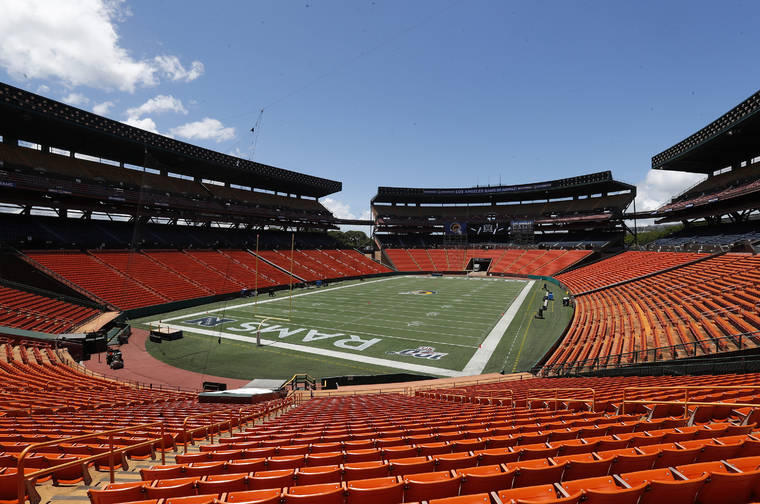Aloha Stadium leadership
So the ambitious redevelopment vision for Halawa includes a new stadium — but is it also becoming a political football?
In July, the governor signed Act 268 into law — the former House Bill 1586 passed by the Legislature got the ball rolling on the new Aloha Stadium Entertainment District. The act authorizes $350 million in state funding to seed a public-private redevelopment of the 96-acre site, to include a smaller stadium, mixed-use retail and commercial spaces, and of course, much-needed housing units.
The act also gave authority for developing the district to the state Hawaii Community Development Authority — a reasonable move given HCDA’s experience in complex land-use matters honed from overseeing Kakaako’s revitalization. HCDA has received its share of criticism over aspects such as insufficient affordable housing requirements, but seems to have improved its community responsiveness.
But now, executive director Aedward Los Banos is leaving HCDA, and this week, the Star-Advertiser’s Ferd Lewis reported that talk is swirling about shifting HCDA to an advisory role, deferring development of the project to the Stadium Authority and the state Department of Accounting and General Services (DAGS). Currently, the governor-appointed, nine-member Stadium Authority governs the use and management of the stadium only. The rationale given for this proposed shift is the desire to expedite completion of a new 35,000-seat stadium in time for the 2023 University of Hawaii football season, and that hedging by the 17-member HCDA board could slow progress. Ironically enough, DAGS itself does not have a great reputation for quick and clear operations.
Expect a bill in the upcoming Legislature to try to clearly delineate roles and responsibilities, said one state senator. Good luck with that, given at least three state agencies, and various politicians, in this turf battle. Taxpayers, keep your eyes on the ball.
Get ready for plastics ban
Officially, this year is public-education time for Oahu’s future: gradual implementation of Bill 40, the ban on single-use plastics. It starts January 2021 with a ban on plastic utensils, and 2022 will do away with to-go plastic cups and polystyrene containers. But progress is already evident through non-plastic utensils offered, fewer plastic straws handed out and experiments with alternative packaging materials.
Customers themselves should start to learn on their own. The new ban is focused on what’s distributed along with ready-to-eat food purchases, but developing a less wasteful ethic encompasses plastic used throughout the average consumer’s day.
There are lots of suggestions online, even this far ahead of the annual environmental observance (www.earthday.org/campaign/end-plastic-pollution Opens in a new tab). April 22, 2020, marks the 50th anniversary of the first Earth Day, so a lot of attention is being paid.
The website includes a “plastic footprint” calculator to help remind people how much of the stuff they use, and then a downloadable toolkit with depictions of the mess plastic makes in the environment. It also outlines much may be quite unnecessary and just habitual. For example, the site dialog prompts the user to think whether they really need every little thing — such as the plastic cup covers for takeout beverages. Would they really spill the drink, otherwise?
The hope is not that these tiny gestures will solve the problem on their own, but that they will alert industry to a new consumer ethic — and the need to reduce plastic in large-scale packaging. This is at least a start.
Hawaii’s population drops
Based on the traffic snarls and general congestion, one would think that Hawaii’s population is rising, even booming. But one would be wrong, according to new numbers that show Hawaii’s population is actually shrinking, for the third year in a row.
New U.S. Census estimates show that the state’s population is now 1,415,872, a drop of 4,700-plus people between July 2018 and July 2019, after accounting for births, deaths and migration.
Much more than mere facts and figures, Hawaii’s three-year downward population trend is alarming for its economic implications. The state’s labor force, government services and business development can be affected, state business and economic development Director Mike McCartney told Hawaii Public Radio this week.
Speaking of population: 2020 is a significant year for Hawaii in the U.S. Census. Every 10 years, the Census Bureau makes a mighty effort to count every person in America. This population tally is important, as it helps determine each state’s number of U.S. House seats as well as federal money allotted for public services like hospitals, schools and roads. To this end, a public-service campaign has been launched, enlisting local notables such as Marcus Mariota and Henry Kapono, aimed at counting as many Hawaii people as possible.

